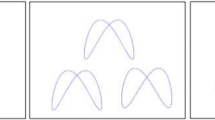Summary
Visual identification of shapes, figures, objects and faces was tested in a group of 26 patients with homonymous field defects due to unilateral “posterior” brain damage. In addition, a search test was used for evaluation of the effect of visual field loss on visual information acquisition. Of the patients, 5 performed entirely normally, i.e. errorless and within age-matched time limits, in all tests. The majority of patients (n = 15) also performed correctly but required significantly more time than normals. In contrast, 6 patients showed a rather specific impairment in visual identification tasks. It is argued that visual field loss per se does not impair visual identification but may affect visual search and, thus, information acquisition. Visual identification may be impaired, however, if brain damage involves the inferotemporal cortex.
Similar content being viewed by others
References
Alexander MP, Albert ML (1983) The anatomical basis of visual agnosia. In: Kertesz A (ed) Localization in neuropsychology. Academic Press, New York
Benton AL, Van Allen MW (1968) Impairment of facial identification in patients with cerebral disease. Cortex 4:344–358
Birch HG, Belmont J, Karp E (1967) Delayed information processing and extinction following cerebral damage. Brain 90:113–130
Chedru F, Leblanc M, Lhermitte F (1973) Visual searching in normal and brain-damaged subjects (Contribution to the study of unilateral inattention). Cortex 9:94–111
Lissauer H (1890) Ein Fall von Seelenblindheit nebst einem Beitrag zur Therapie derselben. Arch Psychiatr Nervenkr 21:222–270
Poppelreuter W (1917) Die psychischen Schädigungen durch Kopfschulß im Kriege 1914-16. Bd 1: Die Störungen der niederen and höheren Sehleistungen durch Verletzungen des Okzipitalhirns. L Voss, Leipzig
Siemerling E (1890) Ein Fall von sogenannter Seelenblindheit nebst anderweitigen cerebralen Symptomen. Arch Psychiatr Nervenkr 21:294–299
Ungerleider LG, Mishkin M (1982) Two cortical visual systems. In: Ingle DJ, Goodale MA, Mansfield RJW (eds) Analysis of visual behavior. The MIT Press, Cambridge, MA
Vanderplas JM, Garvin EA (1959) The association value of random shapes. J Exp Psychol 57:147–154
Warrington EK (1985) Agnosia: the impairment of object recognition. In: Frederiks JAM (ed) Handbook of clinical neurology, vol 1 (45): Clinical neuropsychology. Elsevier Science Publishers, Amsterdam
Weiskrantz L, Saunders RC (1984) Impairments of visual object transforms in monkeys. Brain 107:1033–1072
Zihl J, von Cramon D (1986) Zerebrale Sehstörungen. Kohlhammer Verlag, Stuttgart
Author information
Authors and Affiliations
Rights and permissions
About this article
Cite this article
Zihl, J., Wohlfarth-Englert, A. The influence of visual field disorders on visual identification tasks. Eur Arch Psychiatr Neurol Sci 236, 61–64 (1986). https://doi.org/10.1007/BF00641061
Received:
Issue Date:
DOI: https://doi.org/10.1007/BF00641061




